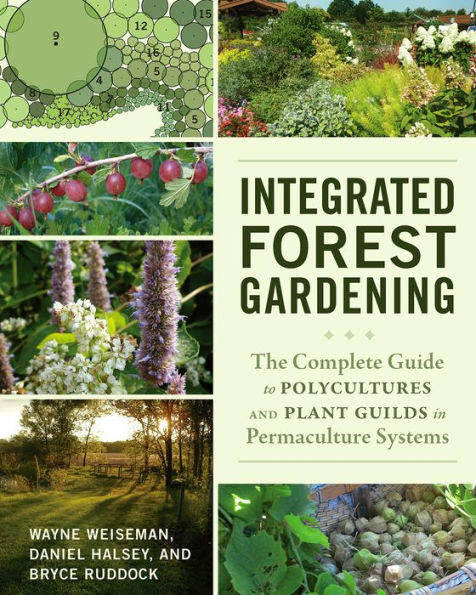Table of Contents
Chapter 1 What is Integrated Forest Gardening? 1
The Permaculture Design System
The Design Process
Essential Templares of Good Design
What Is Forest Gardening?
Perennials and Polycultures
Climate and Scale
Climate Change and the Importance of Integrated Crop Production
Capturing, Storing, Cycling, and the Sustainable Homestead
A Word About Compost: Extending the Life of a Resource
Water and Earthworks
What Is a Plant Guild?
The Scientific Basis for Plant Guilds
The Importance of Plant Diversity
Applications of Plant Guilds in Permaculture and Forest Gardening
How Guilds Work
Designing for the Niche
Studying Guilds in Their Natural State
Chapter 2 The Structure of a Plant Guild 37
Perennial Polycultures
Denning Your Niche
Nutrient Cycling
Carrying Capacity
Understanding the Context of Your Site
Start from Scratch or Follow Nature's Lead?
The Integrated Living System
Niche Dynamics
Designing for Cooperative Competition
The Importance of Sunlight
The Position of Plants
Determining the Quality of Your Soil
Building for Nutrient Cycling
Needs of a Forest Garden
Five Considerations for Sustainable Design
Permaculture Principles to Apply to Guild Design
Yeomans's Scale of Relative Permanence
Constructing the Plant Guild
Questions You May Be Asking
Chapter 3 Selecting Plants for Guild Design 93
Understanding the Biome
Functions of Plant Guilds and Polycultures
Covering the Soil with a Blanket of Vegetation
The Soil Regime
Soils and Salt Tolerance
Catastrophic Occurrences
Agricultural Toxins
When the Wind Doth Blow
Terra Preta: The Dark Earth
Growing Zones
Selecting Plants for Resilience
Understanding Sun Exposure
Determine Your Soil Types
Understanding a Plant's Tolerances
Guild Design Basics Roots: Anchors and So Much More
The Fabulous Fungi
Nitrogen-Fixing Plants
Seasonal Considerations
Bloom Times
Fruit Set
Patterns of Growth
Populating the Guild
The Natural Range of Plants
The Importance of Diversity
Chapter 4 Trees: the Essence of the Plant Guild 151
Duir: Opening the Door on the Oak Tree
The Precious Pine Old Man Hickory
The Maple: Sugar in the Gourd
Chapter 5 Designing for Optimal Species Integration 173
Beneficial Behaviors in the Permaculture Guild
Using Plants in Functional Pest Strategies
Agroforestry Techniques
Specific Plant and Animal Interactions in the Plant Guild
Everything and Everyone Is Lunch
Chapter 6 Management 201
Implementation Time Line
What Are the Broad Site Preparations?
What Is the Sequence complementation?
What Steps "Complete" the Design Implementation?
What Is Needed for Long-Term, or Protracted, Implementation?
Budgeting the Financing
Time Lines Design Decisions and Checklist
The Budget Implementation, Management, and Maintenance
Chapter 7 Case Studies: Fifteen Plant Guilds 215
Fruit and Nut Guild
Pawpaw Delight Guild
Four Vines Guild
Annual-Perennial Guild
Poisonous Plant Guild
Asian Pear Poly-culture Guild
Ginseng/Sugar Maple Polyculture Guild
Boreal Forest Berry Guild
Salsa Garden Guild
Dwarf Cherry Tree Polyculture Guild
Ruddock Guilds
Moving Forward…
Acknowledgments 283
Appendix 285
Notes 289
Resources 293
Index 299



